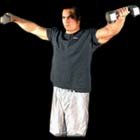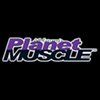Flash: The most important "muscle" for producing eye-popping mass is not really a muscle at all; instead, it's the major tenet of your central nervous system (CNS) muscle building processes, the neuromuscular junction (NMJ).
The neuromuscular junction is where the nerve cell ends and the muscle cell begins. This is the "transfer functional unit" where chemical messages from the brain (neurotransmitters) are delivered to your muscles.
Unlike muscles and organ systems, which are readily identifiable and easily quantified (for example, the right or left bicep), there are literally billions of neuromuscular junctions throughout your body, in your heart, eyelids and slammed all through your skeletal muscle (the type of muscles that you "flex").
So, big deal, you say? Yes, indeed, without neural input from the brain and spinal cord - in the form of neurotransmitters - the muscles cannot and will not act. Each muscle cell (or bundle of muscle cells) must be stimulated by CNS chemical messengers before they will move limbs and grow themselves.
If you can increase the efficiency or rate of neurotransmitter exchange across the neuromuscular junction, you can increase the power of each muscular contraction and the amount of work (reps x weight) performed during each set. More work means bigger, stronger muscles. Best of all, you can increase NMJ function without over-training.
Optimize Maximum Activity At The Neuromuscular Junction
Resistance Training
 The NMJ is where the tip of a nerve and muscle fibers meet, where, when called upon by the brain, electrical signals and chemical messengers are delivered deep within the muscle tissues. These neural transmissions stimulate a cascade of events including the release of calcium ions, the shifting of thick and thin filaments and mitochondria activation within the muscle. These deliberate intracellular events yield forceful muscle contraction.
The NMJ is where the tip of a nerve and muscle fibers meet, where, when called upon by the brain, electrical signals and chemical messengers are delivered deep within the muscle tissues. These neural transmissions stimulate a cascade of events including the release of calcium ions, the shifting of thick and thin filaments and mitochondria activation within the muscle. These deliberate intracellular events yield forceful muscle contraction.
With electromyography (EMG), scientists have determined that the stronger the brain's signal, the greater the electrical activity in the muscle fibers. So, while muscular growth is often attributed to the increase in size and number of muscle fibers, the fact that pumping iron, resistance training amplified neural response at the neural muscular junction may be more significant. Without the CNS, there is no contraction!
Neural stimulation of muscle fibers is not an all or nothing event. When the body needs to lift/move something very heavy or very quickly, there is extensive activity at the NMJ. With lighter loads, gentler contractions can be achieved through weaker neural signals to the muscle(s). The more muscle fibers you can neurally trigger for a longer period of time or at more frequent intervals, the bigger, stronger, and faster you become.
Diet
Garbage in equals garbage out! The myosin (one of the two major fiber types in muscle) is completely broken down and replaced once a week! This is one of the reasons it's so important to consume a diet that's rich in protein, particularly the eight essential amino acids and glutamine. You must stockpile your body with amino acids for neurotransmitter synthesis. Many of the same amino acids that are involved in muscle repair and rebuilding also act as substrates in creation of neuro-hormones like dopamine, L-dopa, acetylcholine and serotonin.
Foods that are rich in tryptophan are readily converted into the relaxing hormone serotonin. (That is why you get tired after a Thanksgiving dinner and why warm milk helps you sleep better at night.) Carbohydrates also stimulate serotonin production by increasing insulin secretion, which indirectly elevates serum tryptophan concentrations by lowering the levels of other amino acids in the blood stream.
In contrast, most protein foods that derive less of their total protein content from tryptophan and a greater extent from tyrosine and phenylalanine, decrease serum tryptophan concentrations by fostering dopamine and norepinepherine. You can modify energy levels, maximize neurotransmitter stores, increase alertness and mental capacity and even change your mood through food. Consume about one gram of protein for each pound of body weight every day, eggs, cheese, milk, beef, poultry, fish, soybeans, and pork. There are also a number of high-quality supplements available from whey, milk, casein, egg whites, and isolated soy proteins.
Rest
Fatigue truly results from impairment at the neuromuscular junction. This is due to weakened electrical stimulus resulting from decreased availability of neurotransmitters. This generally occurs in less than five minutes. Next, phosphocreatine levels become depleted and lactic acid accumulates in the muscle tissue. Finally, neuromuscular efficiency decreases. Fewer and fewer muscle fibers are activated with each neural stimulation.
Dietary manipulations can "pre-load" the neurotransmitter supply both in muscle and the brain. Creatine can facilitate phosphocreatine stores. However, exercise and nutrition can not supplant rest and recovery. It takes over one hour even for professional jocks to regain neuromuscular efficiency.
NMJ impairment and reduced neuromuscular efficiency do not depend on lactic acid and "microtrauma;" therefore, you should allow at least 36 hours between workouts involving the same body part(s) to ensure maximal recovery.
Supplementation
These products "supplement" a good diet and active lifestyle, the mind-muscle training link.
Phenylalanine and Tyrosine
These amino acids are precursors to various neurotransmitters, or catecholamines, dopamine, epinephrine, norepinephrine, DOPA used by the brain. Taken in sufficient amounts and/or with other synergistic ingredients, phenylalanine and tyrosine may have pharmaceutical-like results on behavior, alertness, and appetite control, and other psychological/physiological functions through indirect stimulation of the CNS.
Tyrosine elevates catecholamines in the CNS and the plasma. There are links between catecholamines and happiness - even exhilaration - also improved mental performance. Tyrosine increases brain "pools" of norepinepherine, enhancing performance with reduced mental stress.
Phenylalanine is an essential amino acid and can be converted into tyrosine. Unless you have phenylketonuria (PKU) (an inborn error of metabolism where a person cannot convert phenylalanine into tyrosine) supplementation with phenylalanine is probably beneficial for CNS neuron power!
Choline and DMAE
Just as phenylalanine and tyrosine support the manufacture of brain neurotransmitters, choline is an important component in acetylcholine - the principal catecholamine at the NMJ. Your muscles will not contract without acetylcholine.
Choline is found in egg yolks, liver, fatty fish, peanuts, wheat germ, and whole soybeans. Though nutritious, these foods are high in calories, fat, and/or cholesterol, so supplementing choline is the way to go. Learn the nutrient value of over 6,000 foods, click here!
Supplemental choline is available as choline bitartrate, lecithin, and DMAE. I believe that choline bitartrate and lecithin are best for two reasons. Neither lecithin nor choline bitartrate are pure choline. Lecithin can be 35-50% choline by weight and choline bitartrate only 40%. So, to get an efficacious dose of choline (1-4 g/day), you need to consume about twice as much of these ingredients. DMAE is more potent. DMAE is bio-available and crosses the blood-brain barrier easily. Much smaller doses (25-200 mg./day) of DMAE can be taken to illicit strong responses at the NMJ.
Often referred to as "the most widely used psychoactive substance on earth," caffeine affects behavior, physiological, and psychological functions, by countering the activity of a naturally occurring chemical called adenosine in the human brain. Caffeine increases brain activity and alertness, improves muscle performance, stimulates release of intracellular calcium, leading to greater force and stronger muscular contraction. Caffeine stimulates the release of free fatty acids from the liver and muscle, helping with weight-loss/maintenance and improving endurance.
If you drink coffee, tea, or soda you may already get enough caffeine to maximize performance. If, on the other hand, you don't regularly consume these or other caffeine containing foods (chocolate, caffeinated sports drinks, bars, or gels, certain pain killers, etc.) then you may benefit from supplemental caffeine. For best results, try 200-300 mg. of caffeine, 30-45 minutes before training. A 6-oz. cup of coffee contains about 110 mg. of caffeine and a 12-oz. can of soda, about 45 mg.
[Editor's note: Complete Diet Boost from Optimum Nutrition provides 250 mg. of caffeine, Advantra-Z™ - a natural source of synepherine, Metabromine-G for theobromine, tyrosine, DMAE, phenylalanine, green tea extract, and over 20 other active ingredients.]
Limit your daily use to 600 mg. from all caffeine sources. Caffeine can have side effects in sensitive individuals. If you have high blood pressure, heart disease, diabetes, or other serious medical conditions, or if you are pregnant or nursing, have a sensitive stomach, or get jitters or palpitations from other stimulants, consult a physician before increasing caffeine.
Cacao Extract (Theobromine)
Like caffeine, theobromine belongs to an alkaloid class of molecules known as methylxanthines. Coffee, gurarana, and kola nut contain high concentrations of caffeine, but theophylline is the main methylxanthine in tea and products from the cocoa tree. Theobromine acts similarly to caffeine and is a powerful molecule, acting directly on various physiological systems including the CNS, cardiovascular system, and kidneys. In fact, its effects on blood vessels and the renal system are so pronounced, theobromine has been used as a diuretic and hypertensive medication. It is possible to obtain theobromine through foods, but the best dietary source is chocolate!
Chocolate can supply 100 to 1000 mg. of theobromine per ounce - (dark chocolate is highest). But, you don't want the fat and sugar. Standardized cacao extracts like Metabromine-G are concentrated with fewer calories. Theobromine is similar to caffeine in its positive - and potentially negative - effects, so be sure to consult a qualified medical professional before using it if you have those same mitigating conditions.
Muscle Mass Summation!
- Growth begins at the neuromuscular junction (NMJ).
- Maximize NMJ efficiency by manipulating nutrition, training and rest/recovery routines.
- Dietary supplements can "pre-load" neurotransmitter synthesis. Examples are tyrosine, phenylalanine, caffeine, choline, and theobromine.
[Editor's notes: Make sure you use supplements by companies specializing in these areas. Our independent testing suggests that Optimum Nutrition is probably No. 1 in this area.]
Thanks,
